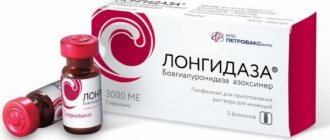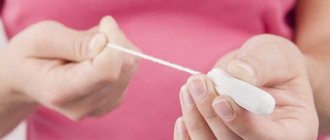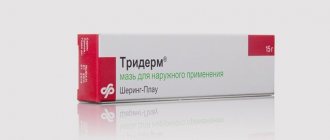Lidaza suppositories are an effective medicine that is used to treat inflammatory diseases in the field of gynecology and proctology. It has pronounced bactericidal properties, acting as the main or auxiliary drug in the systemic treatment of diseases of the internal genital organs in women.
The medication is equipped with detailed instructions for its use, which contains indications for the use of the drug, contraindications, and possible adverse reactions of the body.
Lidase suppositories have the following therapeutic properties, the presence of which allows the medication to be used in the treatment of gynecological diseases of various etiologies:
- accelerates the process of tissue regeneration and promotes healing of wound surfaces, ulcers, cracks, erosions;
- acts as an immunomodulator, which is especially important in the treatment of women with weakened immune systems who have undergone surgery on the internal genital organs;
- relieves inflammation of the mucous membrane of the vagina and cervix;
- helps restore normal functioning of the inner layer of the uterus - the endometrium;
- has an antioxidant effect, preventing premature aging and changes in epithelial tissues;
- removes swelling of the mucous membrane of the vagina and internal genital organs after bruises, mechanical damage, trauma and the consequences of surgery.
Lidaza suppositories can be used as the main drug in preparing the patient for gynecological manipulations and diagnostic examination of the uterus.
For example, before or after curettage of the reproductive organ, collection of tissue samples for histological examination for the presence of cancer cells. The therapeutic properties of anti-inflammatory suppositories are indicated in the instructions for use of the drug.
How to dilute and use Dimexide and Lidaza
Tampons with Lidaza and Dimexide are used to improve blood circulation in the pelvis and quickly restore the mucous membrane. Dimexide is diluted with Lidaza in a ratio of 1:3. This treatment should be prescribed by a gynecologist. Too much concentration of Dimexide can cause burns.
For therapy, an aqueous concentrate with 10-30% of the drug is used. The water must be boiled. To get a 10% solution you need to take 2 ml of the drug and 18 ml of water. To obtain a 30% solution, you need to take 6 ml of water and 14 ml of medication.
To make a tampon, you need to take a little sterile cotton wool and 20 cm of bandage. Cotton wool is placed in the middle of the bandage strip and 2 knots are tied along the edges. The ends of the bandage will help you remove the tampon. The procedures are carried out 2 times a day, morning and evening.
Lidaza in gynecology for endometriosis
Among the many causes of female infertility, ordinary adhesions occupy a special place. How to deal with them without harming your own health?
One of the most common consequences of gynecological diseases is chronic adhesions. It appears in response to inflammation, endometriosis, or surgery. They, like a cocoon, entangle a woman’s reproductive organs, deprive them of mobility and very often become the cause of infertility.
Their symptoms can be erased, but it is still worth paying attention to the fact that long-term debilitating pain, fatigue and depression are eternal companions of the chronic adhesive process.
It can last for YEARS, and during this time the reproductive organs become increasingly immobile, blood circulation is impaired, and oxygen and nutrients are poorly supplied to them. And as a result, the chances of becoming a mother of a healthy baby become even smaller. The process of formation of adhesions can be slowed down. It is necessary to undergo a course of treatment.
After all, adhesions are always accompanied by many unpleasant sensations, which are due to intestinal irritation, blood stagnation in the pelvic organs, and the development of immune-hormonal diseases, for example, endometriosis.
In case of a chronic adhesive process, it is necessary, first of all, to restore the proper functioning of the ovaries and intestines, to relieve pain and a depressive mood in a woman.
Doctors also recommend reconsidering taste preferences and, together with a good gastroenterologist, choosing an individual diet that is favorable for the intestines. In addition, home therapeutic exercises are also necessary. It is simple and yet effective, despite the fact that many tend to underestimate its power. All you need to do is take the knee-elbow and knee-chest positions 3 times a day.
Physiotherapeutic procedures also help. Exposure to ultrasound or currents quickly relieves pain and actively fights adhesions. Electrophoresis has also proven itself to be a unique method of delivering substances, such as iodine, directly to the affected organs.
However, this is not suitable for all women. During periods of exacerbation of inflammation, physiotherapy is contraindicated.
Radon baths may help some. But lidase, beloved by gynecologists, unfortunately, does not live up to the hopes placed on it.
One course of physiotherapy will not be enough, but it is not advisable to carry out more than two or three. If there is no effect from such treatment, laparoscopy is performed and, if necessary, the adhesions are dissected.
Approximately every fifth woman manages to become pregnant naturally after this. But this is only possible subject to an individual approach to treatment and strict adherence to all recommendations on the regimen and lifestyle.
The most effective suppositories for endometriosis
The female body is often affected by endometriosis. This disease is characterized by the growth of the mucous membrane outside the uterus. It is caused by hormonal imbalance.
If a disease of the reproductive system is discovered late, then it can only be dealt with through surgery. But at the initial stage, suppositories for endometriosis may well help. They are prescribed by the attending physician to combat the disease as part of complex therapy.
Suppositories as a dosage form
Doctors often prescribe suppositories that are inserted both anally and vaginally. As a rule, they relieve pain, have anti-inflammatory, antitumor effects and have an antiseptic effect.
If pathology occurs on the cervix and vagina, then vaginal suppositories will be most effective, since they directly interact with the lesions.
The advantage of suppositories as a medicine is that the components of the drug enter the bloodstream and to the site of action, bypassing the stomach and intestines, without harming the mucous membrane of these organs and without loading the liver.
What suppositories are used in the treatment of endometriosis
Vaginal suppositories are used infrequently for the treatment of endometriosis, because this disease is characterized by menstrual irregularities with frequent unexpected bleeding, which washes the active ingredients out of the vagina. As a result, the beneficial effect is not achieved.
But the effect of rectal suppositories is much more effective, they are quickly absorbed, and also:
- remove inflammation;
- help damaged uterine tissues heal faster;
- increase the immunity of the pelvic organs;
- prevent infection from developing.
The course of treatment is prescribed by the attending physician in combination with other medications prescribed in the form of tablets and injections.
To relieve pain, gynecologists recommend:
- Diclofenac. It is administered rectally once a day. Do not use during pregnancy.
- Indomethacin. The gynecologist individually selects a course of treatment with suppositories to combat endometrial pathology. After achieving a positive effect, the doctor adjusts the dosage. Providing an analgesic effect, the drug does not disturb the vaginal microflora.
- Anuzol. Suppositories are inserted into the anus once or twice a day.
- Longidaza. Anti-inflammatory gynecological suppositories also work well against adhesions and prevent their formation.
- Endometrin. The drug restores normal hormonal levels.
Regular use of such suppositories for endometriosis not only relieves pain, but also reduces the manifestations of inflammation.
Since the disease occurs against the background of a lack of the hormone progesterone in the body, suppositories are successfully used to treat endometriosis, replenishing the deficiency of this biologically active substance. The most effective and frequently used:
Any of these medications is prescribed exclusively by a doctor familiar with the woman’s medical history.
Often, during the course of the pathology, adhesions form in women. As a result of this process, the fallopian tubes are damaged. This can lead to ectopic pregnancy or infertility.
The use of Longidaza rectal or vaginal suppositories helps stop the formation of new ones and get rid of existing adhesions. For endometriosis, such suppositories are placed at night once every two days. 10 pieces are required for the course.
The method of administration is determined by the attending physician.
Endometriosis greatly weakens the body. To restore not only local, but also general immunity and increase the resistance of organs and tissues to infections and bacteria, rectal suppositories were developed. They contain human interferon and have almost no contraindications. Such drugs include:
These medications also have an antiviral effect. They must be used strictly following the doctor's recommendations.
Advantages and contraindications
Among the advantages of vaginal suppositories, as mentioned above, are:
- rapid absorption of the active substance into the blood and tissues of the affected organ;
- no negative effect on the stomach, intestinal tract and liver.
But suppositories, like other medications, have contraindications and side effects. Contraindications most often include:
- first trimester of pregnancy;
- lactation period;
- disorders of the liver or kidneys;
- allergy to any of the components of the drug;
- tachycardia.
Each drug has its own contraindications, so be sure to read the instructions before using them. And only a specialist with appropriate education can prescribe medications.
Side effects usually include:
- allergic manifestations;
- constipation or diarrhea;
- headache;
- insomnia;
- urinary retention;
- convulsions.
If any of the symptoms appear, you should consult your doctor.
Types of suppositories for the treatment of pathology
For diseases of the uterus such as endometriosis, various types of suppositories are used as an auxiliary treatment. They are selected by the doctor depending on the woman’s condition.
The most effective and most frequently prescribed suppositories for endometriosis: Longidaza, Indomethacin, Viferon, Galavit, Terzhinan, Antikan.
Source: https://ginekologiya-urologiya.ru/endometrioz/lidaza-v-ginekologii-pri-endometrioze
How do candles work?
In the pelvis, adhesions are formed on the basis of connective tissue , which contains hyaluronic acid. Lidaza is one of those agents that can dissolve it. The key component of the product is hyaluronidase, an enzyme that promotes the breakdown of acid. The connective tissue loses its elasticity, the tissues of the genital organs will become permeable, and scars in the ovaries, uterine and other organs will also dissolve.
The drug Lidaza is used not only in gynecology, it is also used for such diagnoses as:
- rheumatism;
- burn scars;
- osteoarthritis;
- stiff joints.
If we talk about gynecology, suppositories are used to treat adhesions after surgery on the pelvic organs, infertility due to adhesive disease and other diseases of the female reproductive system.
Application
The natural medicinal formula of Lidaza suppositories allows them to be used to treat patients of the adult and pediatric age groups. The final procedure for using the medication is determined by the attending gynecologist, but the instructions that come with the drug also contain detailed information about the organization of the therapeutic process.
For children under 18 years old
In gynecological practice, Lidaza suppositories are used to treat girls who have been diagnosed with inflammatory diseases of the reproductive system. The drug is approved for use in children at least 12 years of age.
Lidaza suppositories: instructions for use
In gynecology, this drug is used not only in the form of suppositories, but also in the form of injections. If we talk about candles, they are produced in limited quantities , they are not available for free sale, so you can buy them only by prescription, each time they are delivered by pre-order.
Instructions for use involve the introduction of one suppository per day into the vagina every two days on the third. The course consists of 10 injections of suppositories.
Also in gynecology, Lidaza is used in conjunction with electrophoresis. Using direct current, local applications are made with the active substance of the product, due to which hyaluronylase enters the pelvic organs and has a resorption effect. Typically, doctors prescribe a course of treatment consisting of ten such procedures. Some require several courses a row, it all depends on the course of the disease and medical indications.
As for Lidaza in the form of injections, they are given into the ovary or subcutaneously. The effect of the drug lasts about two days.
In some cases, for adhesive disease, Lidase-based tampons are prescribed; it is recommended to use them daily before bed at least 10 times. At the same time, a resolving and anti-inflammatory effect occurs when Lidase is used together with Dimexide.
Compound
Lidase suppositories have a simple biochemical composition, which ensures their good absorption by the female body and minimizes the likelihood of allergies and other negative reactions. The table below shows the components of the drug, as well as their pharmacological significance in the treatment of diseases of the female reproductive system.
| Active and auxiliary components of Lidaza suppositories | Pharmacological properties of biochemical substances, as well as their effect on the patient’s body |
| Hyaluronidase | The main active substance of suppositories, which belongs to the group of natural enzymes. Hyaluronidase is obtained by industrial isolation from the testes of cattle. Upon contact with the mucous surface of the vagina, it quickly penetrates the mucous membrane and is absorbed into the epithelial tissue. It has an antioxidant and anti-inflammatory effect, relieves swelling, and also promotes more accelerated regeneration of damaged epithelium. Regular supply of hyaluronidase improves local immunity and the body's resistance to bacterial, viral and fungal infections. This property of the active substance of Lidase suppositories is especially useful for women who are undergoing complex treatment for bacterial vaginitis, have undergone surgery on the internal genital organs, or are recovering from uterine curettage. Hyaluronidase improves local blood circulation and trophism of lymphatic fluid, acting as a prophylactic against inflammatory diseases of the endometrial layer of the uterus, its cervix, and ovaries. Systemic delivery of Hyaluronidase into the tissues of the internal genital organs is indicated for women who have previously suffered from diseases of the reproductive system and are faced with the problem of secondary infertility, or do not have medical pathologies, but have been unable to conceive a child for a long period of time. |
| Cacao butter | An auxiliary substance for Lidaza suppositories, which acts as the basis for the formation of a suppository weighing 1.3 g. Provides easy and painless insertion of the suppository into the vaginal cavity. Under the influence of the patient’s body temperature, cocoa butter quickly dissolves and mixes with the mucous membrane. The high content of natural lipids gives the excipient the properties of a natural conductor of the main component of the drug. Cocoa butter does not cause adverse reactions, does not provoke local irritation, and does not cause the formation of edema. The only exceptions are patients who have individual intolerance to cocoa beans, expressed in a local allergic reaction. |
Lidaza (suppositories), the instructions for use of which contain detailed information about the biochemical composition of the drug, belong to the category of gynecological drugs with a completely natural therapeutic basis.
This feature of the drug allows it to be used to treat women who, due to the individual characteristics of the body, cannot tolerate anti-inflammatory chemicals.
Overdose
Sometimes during treatment an overdose of the drug occurs. It manifests itself in the form of symptoms such as:
- skin rashes;
- dizziness;
- chills;
- nausea;
- tachycardia;
- hives;
- blood pressure surges;
- swelling in the area of use;
- gagging.
If any symptom occurs, the patient must urgently administer epinephrine or antihistamines.
Tampon making technique
How to make medicated tampons at home? You need to make a tampon yourself from sterile materials. It is not recommended to use ready-made tampons, as they are already impregnated with other substances that can cause side effects.
READ ALSO: Solving infertility problems
To make a tampon you need to stock up on cotton wool, bandage or gauze and thread. All materials must be sterile. The instruments used to make a therapeutic tampon must be sterilized or treated with medical alcohol. Hands are cleaned with antibacterial soap or sterile gloves are worn. There are two ways to make tampons with Dimexide:
Technique for creating an oblong tampon:
- Cut a piece of bandage 15 to 20 cm long.
- Tightly roll a piece of cotton wool, 3 cm in diameter, so that it resembles a cylinder shape.
- Secure the tampon on top with a thread treated with alcohol, wrap it in a bandage, tie the edges tightly so that a “tail” is formed that will extend beyond the vagina to easily remove the product.
A round tampon is made as follows:
- A piece of cotton wool is rolled into a tight ball.
- The bundle is soaked in a pre-diluted solution and lightly squeezed.
- The sanitary product is wrapped in a bandage so that the edge is turned inward, and it is tightened with thread.
After getting wet, the size of the remedy increases. To avoid this, you need to wrap the cotton wool tightly with a bandage and secure it with a thread. In addition, do not forget about the “tail” of the tampon, which ensures easy removal of the bundle from the vagina. Only after checking these points can you insert a tampon.
Terms of use and cost
As for joint use with other drugs, Lidaza tends to enhance the effect of local anesthetics and is often used to improve the absorption of other drugs.
Doctors prescribe the drug with extreme caution simultaneously with certain other drugs, since there is a risk of increased absorption , and there is also the possibility of systemic action.
Lidase cannot be stored in conditions of high humidity and high temperature; the permissible storage mode is up to 25 degrees. The shelf life is 2 years from the date of production in an airtight container. It is not recommended to store the product after the expiration date.
Lidaz candles are not very expensive, the average cost is 160-250 rubles.
Lidaza for endometriosis
Endometriosis is a frequently diagnosed female pathology of hormonal origin, characterized by the growth of the uterine endometrium and its extension beyond the organ.
Late stages of the disease are treated exclusively with surgery. But in the initial form of endometriosis, suppositories show a good therapeutic result.
Suppositories for endometriosis
Suppositories are recognized by gynecologists as one of the most convenient forms and are therefore prescribed for various gynecological pathologies.
But vaginal suppositories for endometriosis are recommended relatively infrequently, due to prolonged bleeding or regular “spotting” typical for the disease.
If such symptoms are present, medications are washed out of the vagina without providing the necessary therapeutic effect.
Rectal suppositories are prescribed for the treatment of endometriosis. They may have both anti-inflammatory and analgesic properties.
There are three formats of the medicinal product:
- vaginal - immersed deep into the vaginal tube, as close to the cervix as possible;
- rectal - inserted exclusively into the rectum;
- sticks - used for insertion into the cervix, lumen of the ureter.
The main advantage is the delivery of the medicinal component directly to the area of inflammation. The active substance penetrates into the general bloodstream 30 minutes after placing the suppository.
Hexicon
Hexicon suppositories are an anti-inflammatory agent with an antiseptic effect that helps localize the inflammatory process. The active ingredient is digluconate chlorhexidine. After the suppositories are dissolved, the microflora of the vaginal and cervical mucosa does not become disrupted.
Application regimen: 2 times a day for 10 days. If necessary, the course of therapy is repeated.
Longidaza for endometriosis
The disease is characterized by the formation of adhesions, which causes damage to the fallopian tubes. Their obstruction leads to the development of infertility or the occurrence of ectopic pregnancy.
Longidza suppositories are prescribed to destroy the formed adhesions and stop their further formation. The full course of treatment is 10 suppositories administered every other day. If necessary, therapy can be repeated three to four months after the end of the first course.
For endometriosis, these suppositories can be used for both rectal and vaginal administration. The method is determined by the attending physician.
Indomethacin
Indomethacin suppositories are another drug used in the treatment of pathological proliferation of endometrial tissues, which has an anti-inflammatory, analgesic and weak antipyretic effect.
They are inserted deep into the vagina three times a day. Course duration is a week. Indomethacin does not cause changes in local microflora, but minor bleeding may develop during treatment.
Panzerin candles
Panzerin suppositories can be used both vaginally, inserting them deep into the vagina, and rectally.
Treatment can be continued during menstruation, but during this period the suppository is administered exclusively into the rectum.
To understand how the disease occurs, consider the structure of the uterus. The inner surface of the uterus is covered by a mucous membrane - the endometrium. Every month, the endometrium matures so that a fertilized egg can attach to it. If pregnancy does not occur, the layer separates during the menstrual cycle, and this process is accompanied by bleeding.
Particles of the endometrium, along with menstrual blood, can enter the fallopian tubes, abdominal cavity and attach there to the internal organs. In a new place, the endometrium behaves in the same way as in the uterus: it bleeds and is renewed every month. Because of this, the surrounding tissues become inflamed, causing pain and complications.
- intrauterine manipulations: abortion, caesarean section, cleaning of the uterine cavity;
- genital surgery;
- childbirth with complications;
- weak immunity;
- changes in hormonal levels;
- stress and overwork.
- Genital endometriosis affects the pelvic organs: the uterus, ovaries, fallopian tubes, vagina, or external genitalia.
- Extragenital endometriosis received this name because it extends beyond the reproductive system and affects other internal organs: the intestines, bladder, kidneys and even the lungs.
- long and heavy menstruation;
- pain during sexual intercourse and urination;
- menstrual irregularities;
- the duration of menstruation is more than 8 days;
- cycle duration is less than 27 days;
- bleeding after menstruation.
Source: https://mypochki.ru/lidaza-pri-jendometrioze/
Analogs
This tool has the following analogues:
- Lidaza M - has the form of an aerosol;
- Longidaza - has a similar effect. Also available in candle form;
- Ronidase - has the form of a powder for the production of a solution for injection;
- Polyoxidonium - the product has a similar effect to Lidaza, but differs in composition. The key active ingredient here is polyoxidonium. Has immunomodulatory and detoxifying effects. The active substance is easily tolerated and has virtually no side effects. It is possible to use the drug together with antibiotics and even during chemotherapy. It comes in the form of suppositories and powder for preparing an injection solution.
Side effects
Clinical studies of the drug have shown that its active substance is well tolerated by most patients. It does not matter whether the suppositories are administered rectally or vaginally.
In case of individual sensitivity of the body to the constituent components of Lidaza suppositories, the following side effects may occur:
- itching and burning sensation that is felt inside the vagina;
- redness of the mucous membrane of the internal genital organs;
- swelling of the epithelial tissue in the area where the suppository was inserted, as well as the appearance of a small red rash.
All of the above side properties of the medication are a typical manifestation of an allergic reaction to the active substance of Lidase suppositories.
If such symptoms occur, it is necessary to stop drug therapy , perform careful hygiene of the genital organs and visit a gynecologist to prescribe a drug with a different biochemical composition.











